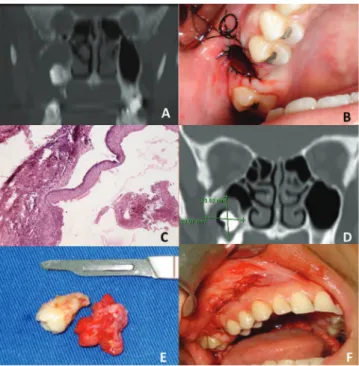Braz J Otorhinolaryngol. 2014;80(2):178-179
www.bjorl.org
Brazilian Journal of
OTORHINOLARYNGOLOGY
1808-8694/$ - see front matter © 2014 Associação Brasileira de Otorrinolaringologia e Cirurgia Cérvico-Facial. Published by Elsevier Editora Ltda. All rights reserved.
DOI: 10.5935/1808-8694.20140035
CASE REPORT
Please cite this article as: Sampieri MBS, Gonçales ES, Tieghi-Neto V, Nogueira AS, Turatti E, Cavalcante RB, et al. Keratocystic odontogenic tumor in the maxillary sinus: a rare occurrence. Braz J Otorhinolaryngol. 2014;80:178-9.
* Corresponding author.
E-mail: mar_sampieri@hotmail.com (M.B.S. Sampieri).
Introduction
In 2005, the World Health Organization revised and updated
the classiication of odontogenic tumor, and some termi
-nologies were modiied. Due to its neoplastic nature, the odontogenic keratocyst, which was previously classiied as a
cyst, had its name changed to keratocystic odontogenic
tu-mor (KCOT). The prevalence of KCOT in the maxillary sinus
is only 1%.1 KCOT has high rate of recurrence,2 and nume-rous surgical modalities such as marsupialization,
sauceriza-tion, Carnoy’s solusauceriza-tion, and enucleation have been used for the treatment of KCOT with different results.3 This article
reports a case of KCOT in maxillary sinus treated with des -compression and enucleation.
Case presentation
A 28-year-old woman was referred for evaluation of an infection in the irst upper molar area, which had been extracted 30 days before. Extraoral examination showed pus drainage through the right nasal fossa. Intraoral exa -mination revealed no swelling, but the area corresponding
to the upper right irst molar was also draining pus. In the coronal view of computed tomography, it was possible to observe an obstruction of the right maxillary sinus by a lesion of cystic aspect associated with a molar tooth. The bone walls were preserved (Fig. 1A). After remission of the acute phase of the infection with the use of a syste
-mic antibiotic, an incision with the removal of the buccal mucosa was performed in order to decompress the lesion
under local anesthesia (Fig. 1B). At the same time, the
intra-lesional material was removed for analysis. The his -topathologic diagnosis was compatible with KCOT. The
his-tological sections presented fragments of cystic capsule coated in focal area by stratiied squamous epithelium in continuity with parakeratinized rather than stratiied epi -thelium (Fig. 1C).
The patient had no complications in the
postoperati-ve period. Monthly follow-ups were performed for irriga
-tion and cleaning of the surgical cavity. After 18 months postoperative, a coronal view of computed tomography showed a considerable regression in the size of the le
-sion (Fig. 1D). The removal the of cyst and the associated tooth was performed under general anesthesia (Fig. 1E), and primary closure of the wound was attained (Fig. 1F).
Keratocystic odontogenic tumor in the maxillary sinus:
a rare occurrence
Tumor odontogênico ceratocístico em seio maxilar: uma ocorrência rara
Marcelo Bonifácio da Silva Sampieri
a,*, Eduardo Sanches Gonçales
a, Victor Tieghi Neto
a,
Alexandre Simões Nogueira
b, Eveline Turatti
c, Roberta Barroso Cavalcante
c,
Virgílio Mendes Maia Júnior
da Bauru Dentistry School, Universidade de São Paulo (FOB-USP), Bauru, SP, Brazil b Dentistry School, Universidade Federal do Ceará (UFC), Sobral, CE, Brazil c Dentistry School, Universidade de Fortaleza (UNIFOR), Fortaleza, CE, Brazil d Private Practice, Granja, CE, Brazil
Keratocystic odontogenic tumor in the maxillary sinus: a rare occurrence 179
No signs of recurrence have been observed in three years of follow-up.
Discussion
KCOT is a pathological entity that requires special attention due to its aggressive behavior and high rate of recurren
-ce. The presence of multiple KCOT can be associated with
Gorlin-Goltz syndrome.4 An important radiographic featu -re is the buccolingual growth without cortical expansion in nonsyndromic cases.5
Six treatment modalities were described: resection; enucleation with peripheral ostectomy and Carnoy’s solu-tion; enucleation with peripheral ostectomy; enucleasolu-tion; decompression; and enucleation with Carnoy’s solution. The
rate of recurrence ranged from 0% to 50%, with an average of 23.15%.3
Few occurrences of KCOT in the maxillary sinus have been described, and the treatment consists of total lesion
removal and bone curettage.2,4,6 The previously mentioned
peripheral ostectomy included additional removal of bone tissue; the execution of this procedure in this case report would not be possible due to the thinness of the maxillary
sinus walls. In the present case, decompression was chosen in order to preserve the surrounding anatomical structures (orbital cavity, maxillary sinus, nasal cavity, and teeth) and avoid a more aggressive surgery. Later, a total lesion
enucle-ation was performed, followed by bone curettage. The le
-sion capsule presented as less friable than the irst surgical intervention, facilitating total removal of the KCOT.
Final remarks
KCOT has a speciic course and high rates of recurrence.
Its occurrence in the maxillary sinus is rare, and computed tomography is essential to determine the lesion extensions and establish the treatment plan. Follow-up must be
conti-nued for at least for ive years, and must be based on clini -cal and radiographic signs.
Conlicts of interest
The authors declare no conlicts of interest.
References
1. Press SG. Odontogenic tumors of the maxillary sinus. Curr Opin Otolaryngol Head Neck Surg. 2008;16:47-54.
2. Vencio EF, Mota A, Pinho CM, Dias Filho AA. Odontogenic kera -tocyst in maxillary sinus with invasive behavior. J Oral Pathol Med. 2006;35:249-51.
3. Kaczmarzyk T, Mojsa I, Stypulkowska J. A systematic review of the recurrence rate for keratocystic odontogenic tumour in relation to treatment modalities. Int J Oral Maxillofac Surg. 2012;41:756-67.
4. Silva GCC, Silva EC, Gomez RS, Vieira TC. Odontogenic kera-tocyst in the maxillary sinus: Report of two cases. Oral Oncol EXTRA. 2006;42:231-4.
5. MacDonald-Jankowski DS. Keratocystic odontogenic tumour: systematic review. Dentomaxillofac Radiol. 2011;40:1-23.
6. Çakur B, Miloglu Ö, Yolcu Ü, Göregen M, Gürsan N. Keratocystic
odontogenic tumor invading the right maxillary sinus: a case report. J Oral Scien. 2008;50:345-9.
Figure 1 A, Coronal view of computed tomography showing the
obstruction of the right maxillary sinus by a lesion of cystic aspect associated with a molar tooth. B, Decompression of the lesion under local anesthesia. C, Coating epithelium
parake-ratinized H&E with 100 × magniication. D, Coronal view at 18
